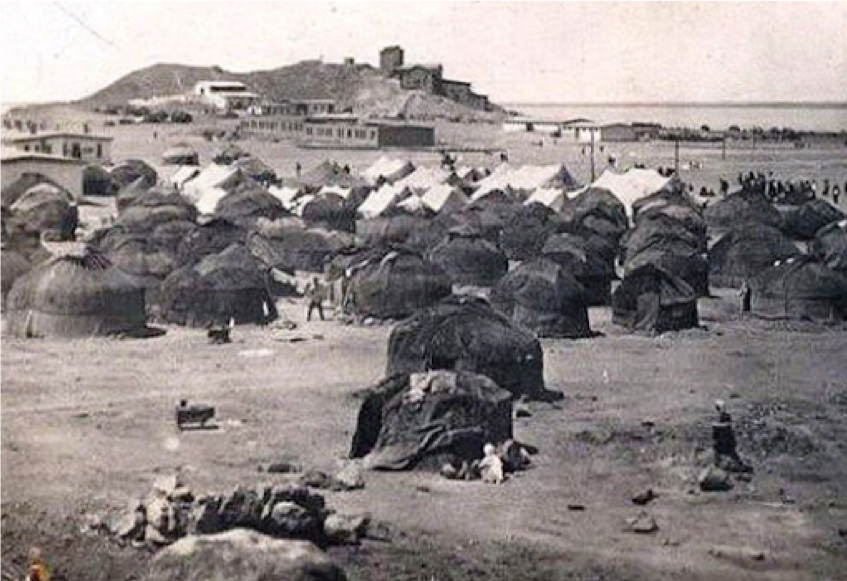The Secrets of Lake Balkhash – Case Study
By Artcom

The region of Lake Balkhash represents the position of the Kazakh steppes, where the interests of China and Russia intersect.
Balkhash is a unique lake in Kazakhstan with an area of 16,400 km2, making it the 13th largest in the world. The transboundary basin of Lake Balkhash is 413,000 km², located in South-Eastern Kazakhstan and the Xinjiang Uighur Autonomous Region of China.
Today, the Lake Balkhash basin is a zone of ecological and social crisis.
Balkhash is important for the analysis of the colonial policy of the USSR. Urbanization and industrialization around the lake occurred during the Soviet period in the late 1920s, which has actively continued alongside collectivization and subsequent artificial famine.

The famine years (1931-1933). Kazakh nomads set up yurts near the Kounrad mine.
The lake was transformed from a natural object into a hidden zone, a “watershed point” and “site assembly point”: the Semipalatinsk nuclear test site, the Saryshagan military test site and the Baikonur space station. On the shores of the lake, is its largest surrounding town , Balkhash, which has a copper smelting plant and whose wastewater flows into the lake. In addition, there is the aforementioned formerly closed military city of Priozersk, which is the administrative center of the Saryshagan Range, as well as the closed city of Balkhash-9 (leased today by Russia), where anti-missile weapons are being tested, serving as Russia’s “radioactive shield” from China.
The water crisis in Central Asia remains severe, and even the collapse of the USSR hadn’t allowed for new economic entities to remove themselves from the practice of ineffective water usage. We believe that the nature of this problem is not in the quantity or scarcity of water resources, but in their misuse and uneven distribution between the Central Asian States and China.
In this context, Lake Balkhash, surrounded by arid steppe, desert and semi-desert lands, plays a strategic political, economic and social role in the region. The lake affects more than 3 million people.
A cornerstone of the management of transboundary waters between Kazakhstan and China is the issue of water resource usage of the Ili and Irtysh rivers. To date, there is no legislation to regulate this, and the many years of bilateral negotiations have only led to the disclosure of hydrological information by China, and to an agreement on the division of the water of the small Khorgos River, in connection with the BRI project.
The main artery of Lake Balkhash is the Ili River, which supplies up to 80 per cent of the water. It begins in China, where reservoirs for irrigation have been established in the upper reaches of the river; large-scale hydropower plants are being constructed, increasing water abstraction, and threatening to drain Lake Balkhash in the near future.
The urgency of economic growth puts pressure on the environment and the environmental situation in the regions. In Kazakhstan, 90 per cent of water resources are used for agriculture, as in Xinjiang. The situation is also exacerbated by global and regional climate change, and the degradation of the basin’s glaciers.
The Chinese Government’s BRI initiative, as well as Kazakhstan’s Nurly Zhol State Program, are a threat to the local environment and ecology, similar to how the USSR’s project on modernization, industrialization and economic development in Central Asia led to ecological and social disasters. Additionally, the lack of resolution on transboundary water management problems has been exacerbated by weak communication between national Governments, international and local environmental organizations, researchers, farmers, industrial organizations, and the public.
Instead of the sacred perception of water held by the nomadic tribes who lived in the territory and had been breeding there, water has now become politicized, alienated, polluted and corrupted by Governments and corporations. These waters are neutral, and have no rights. Communities and ecosystems do not own or have equal access to water, and so the lake continues to be politicized and economically exploited.
An important and pressing task is to decolonize the concept of Balkhash. It is necessary to understand what it was like before the Soviet period, what role Balkhash played in the cultural landscape of the local people. Balkhash, as a repèrepoint, has a great potential for breaking up colonial concepts about the “infertility” of this land. It also has the possibility of becoming a point of attraction for neighboring regions (Karagandy, Zhambyl oblasts), which are currently in an economically degraded zone.
The aim of this project is to study the local values of the lake and understand how these values impact local livelihoods and the everyday lives of the communities. Throughout this project we will engage with local communities through interviews, discussions, and local events to study the values which shape the Balkhash region.
Aigerim Kapar is an independent curator, cultural activist, founder of the creative communication platform «Artcom».
Kulshat Medeuova is Professor of Philosophy at the L.N. Gumilyov Eurasian National University.
The WaterCafè is a fresh wave in attempting to bridge the gap between international and local practices surrounding water governance.
Nataliya Chemayeva (Turkmenistan) is a recent graduate of the MSc in Water Cooperation and Diplomacy (2020) who has been professionally working in the field of environmental strategic planning and project management in Central Asia for almost 5 years.
Bota Sharipova is from Kazakhstan and has been involved in a wide range of water-related transboundary projects in the Aral Sea Basin since 2011.
